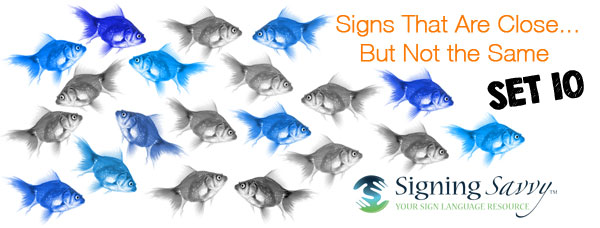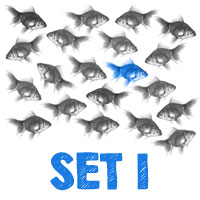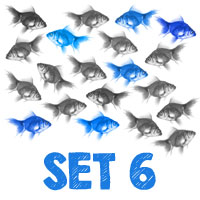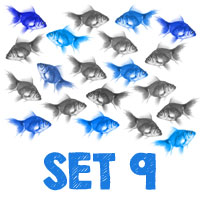
Signs That Are Close... But Not the Same - Set 10
This article is part of our “Signs That Are Close... But Not the Same” series, which highlights signs that look similar, but have different meanings.
The ASL signs shown below look similar, but are not the same. There are many ASL signs that when produced look similar, but in fact have a completely different meaning. Below you will find examples of such signs. Watch closely to see if you can see the differences. In addition, watch my eyebrows, look to see when I tilt my head or lean my body in a certain way, even what my mouth is doing. These nuances are called inflections and trust me, inflections matter.
1. Cafeteria vs. Twin vs. Restaurant
CAFETERIA has the C handshape move from one side of the chin to the other, while TWIN uses the same motion, but uses the T handshape instead. RESTAURANT also uses this same motion, but uses the R handshape.
You can remember the difference between these signs because they each use the handshape that the word starts with (Cafeteria = C handshape; Twin = T handshape; Restaurant = R handshape).
It is called an initialized sign when the first letter of the word is the handshape used in the sign. Often initialized signs are an indication that the sign is a Signing Exact English (SEE) sign, however, these three initialized signs are all excepted as American Sign Language (ASL).
 |
||
2. Socks vs. Stars
SOCKS have the index fingers brush against each other while pointing down (palms inward) and STARS have the index fingers brush against each other (palms outward) while pointing up.
To remember SOCKS, think of the index fingers point downward towards your socks and the movement suggests the sliding on and off of socks. You can also think of knitting socks. Although there is not an early record of the sign for SOCKS in older dictionaries, there is a compound sign described as using your index fingers as knitting needles to make the sign for KNIT and then pointing to your feet. Because of this, it is believed that the sign for SOCKS evolved from the idea of making a knitting movement while pointing to your feet.1
To remember STARS, think of the index fingers pointing up towards the sky, where the stars are. This sign originated from the old French sign for ÉTOILE (star), which is now used in French sign language for ASTROLOGIE (astrology). The sign originally had the index fingers pointing into the sky, indicating points where stars might be, however, the ASL sign evolved over time to have the two index fingers closer together so they make contact.1
 |
3. See vs. Watch
The 2 handshape (also called the V handshape) is used when signing both SEE and WATCH because the two fingers represent the eyes and what the eyes are doing.
The big difference to spot between these two signs is the palm orientation. SEE has the palm facing the body and WATCH has the palm facing outward.
When signing SEE, the palm faces the body and the 2 handshape starts at the face, just below the dominant eye, and pulls away from the body. This movement represents the concept of seeing from the eyes.
WATCH has the 2 handshape, with the palm facing outward, point straight out from the face and move out - think of pointing at what you are watching.
 |
4. Enough vs. Full
When signing ENOUGH, the dominant 5 handshape, with the palm down, slides across the S handshape, suggesting that you are scraping the extra off of the top because there is already enough. To sign FULL (as in "a full container"), the dominant 5 handshape moves across the S handshape from dominant side to non-dominant side and suggests that a container is filled to the brim. There are multiple movements when signing ENOUGH, while there is one swift movement when signing FULL.
 |
How can I figure out the difference between signs on my own?
If you see two signs that look close, but not the same, and you’re not sure, you may use Signing Savvy features to help you figure out the difference. All of our signs have sign descriptions and memory aids that members may access. Reading the sign description and memory aids for the signs will help you figure out the small differences between them that your eyes don’t catch at first. We also recommend using the pause and slow motion feature to slow down the video, so you may take a closer look. These features are available to Signing Savvy members.
Take a look, it's in a book!
These examples are aligned with the Visual Discrimination section of Lesson 6 (page 72) from Lessons and Activities in American Sign Language by Brenda E. Cartwright and Suellen J. Bahleda. Check out the book for more ASL Activities and watch for more examples from this series: “Signs That Are Close... But Not the Same.”
Resources
Signing Savvy is a participant in the Amazon Services LLC Associates Program, an affiliate advertising program designed to provide a means for sites to earn advertising fees by advertising and linking signingsavvy.com to Amazon properties. That means Signing Savvy may contain affiliate links. If you make a purchase after clicking on an affiliate link, your cost will be exactly the same regardless, but Signing Savvy will automatically receive a small commission. Your support is greatly appreciated and helps us continue to improve Signing Savvy!
ADVERTISEMENTS
 Brenda Cartwright is a Coda, seasoned interpreter, a master teacher, well known presenter, and author of several best selling sign language and interpreting textbooks from the RID Press. For 35 years Brenda was the Chair of the Sign Language Interpreter Program at Lansing Community College in Lansing, Michigan.
Brenda Cartwright is a Coda, seasoned interpreter, a master teacher, well known presenter, and author of several best selling sign language and interpreting textbooks from the RID Press. For 35 years Brenda was the Chair of the Sign Language Interpreter Program at Lansing Community College in Lansing, Michigan. Signs That Are Close... But Not the Same - Set 1
Signs That Are Close... But Not the Same - Set 1 Signs That Are Close... But Not the Same - Set 6
Signs That Are Close... But Not the Same - Set 6 Signs That Are Close... But Not the Same - Set 9
Signs That Are Close... But Not the Same - Set 9








SpeedSpellerThursday, February 18, 2021
I couldn''t remember the difference between "Full" and "Enough" when I was signing, but this helps a lot! Thanks :)
-speedspeller